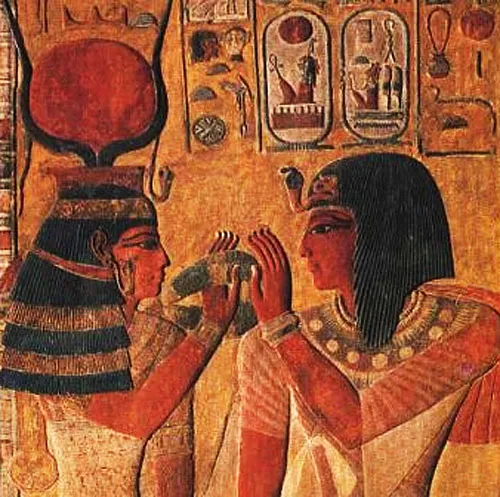
World Music Central
In the Old Kingdom, Hathor was not only one of the Egyptian Goddesses but also an essential one like Isis after her in the New Kingdom. As we can read here:
Hathor (Ancient Egyptian: ḥwt-ḥr, lit. ‘House of Horus’, Ancient Greek: Ἁθώρ Hathōr, Coptic: ϩⲁⲑⲱⲣ) was a major goddess in ancient Egyptian religion who played a wide variety of roles. As a sky deity, she was the mother or consort of the sky god Horus and the sun god Ra, both of whom were connected with kingship, and thus she was the symbolic mother of their earthly representatives, the pharaohs. She was one of several goddesses who acted as the Eye of Ra, Ra’s feminine counterpart, and in this form, she had a vengeful aspect that protected him from his enemies. Her beneficent side represented music, dance, joy, love, sexuality, and maternal care, and she acted as the consort of several male deities and the mother of their sons. These two aspects of the goddess exemplified the Egyptian conception of femininity. Hathor crossed boundaries between worlds, helping deceased souls in the transition to the afterlife.
Hathor was often depicted as a cow, symbolising her maternal and celestial aspect, although her most common form was a woman wearing a headdress of cow horns and a sun disk. She could also be represented as a lioness, cobra, or sycamore tree.
Cattle goddesses similar to Hathor were portrayed in Egyptian art in the fourth millennium BC, but they may not have appeared until the Old Kingdom (c. 2686–2181 BC). With the patronage of Old Kingdom rulers, she became one of Egypt’s most important deities. More temples were dedicated to her than any other goddess; her most prominent temple was Dendera in Upper Egypt. She was also worshipped in the temples of her male consorts. The Egyptians connected her with foreign lands such as Nubia and Canaan and their valuable goods, such as incense and semiprecious stones. Some of the people in those lands adopted her worship. In Egypt, she was one of the deities commonly invoked in private prayers and votive offerings, particularly by women desiring children.
During the New Kingdom (c. 1550–1070 BC), goddesses such as Mut and Isis encroached on Hathor’s position in royal ideology, but she remained one of the most widely worshipped deities. After the end of the New Kingdom, Hathor was increasingly overshadowed by Isis. Still, she continued to be venerated until the extinction of ancient Egyptian religion in the early centuries AD. Wikipedia
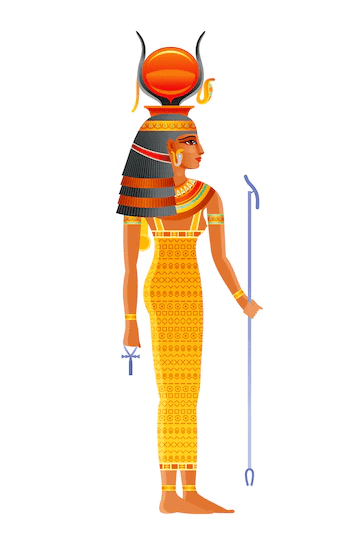
Hathor, Egyptian goddess, sky deity with sun, cow horns. Ancient Egyptian god illustration. Premium Vector
Here is a brilliant description, by Marie Grillot, of a fragment of Hathor sistrum image, as a glorious star, remained of the past.
Thanks to the generosity of a Polish count, this fragment of Hathor’s sistrum is in the Louvre!
via; égyptophile
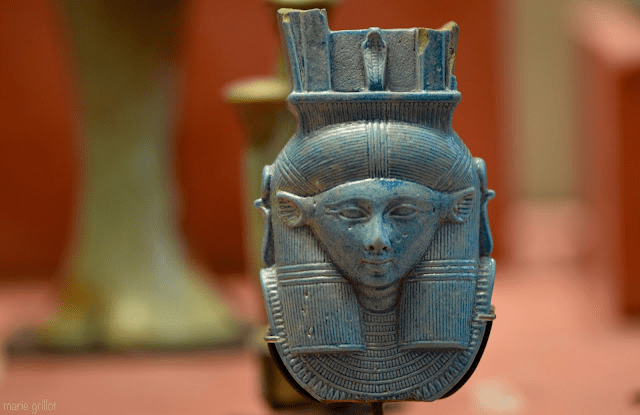
Department of Egyptian Antiquities of the Louvre Museum
donated in 1867 by Count Michel Tyszkiewicz – E 3668
Barely 11 cm high, dated to the XXVIth dynasty, this fragment of Hathoric sistrum is made of faience in a soft and icy blue. The Louvre website specifies what this “Egyptian” earthenware is: it is a: “siliceous ceramic product, that is to say, based on quartz (grains of sand, for example) and not ‘clay. The glaze of the surface is mainly blue-green, obtained from copper oxide.’ The shaping of the object is done: “cold either by the technique of modelling or by the technique of moulding”. The cooking takes place at around 900-1000°C. Over the centuries, the artisans of antiquity achieved a very high degree of mastery of this process.
The goddess wears a heavy straight wig, “which seems most common in the late period”, and whose hair texture is evidenced by fine regular streaks. It covers a good part of his forehead and then leaves in two thick masses, rejected behind the ears and back to frame the cheeks. The hairstyle is adorned – or disciplined – in five places by a triple ribbon.

Sistrum fragment, head of Hathor – 26th dynasty
Department of Egyptian Antiquities of the Louvre Museum
donated in 1867 by Count Michel Tyszkiewicz – E 3668 – photo © 2003 Musée du Louvre / Christian Décamps
Its cow’s ears are rounded, folded, striated in their interior, and released from the head. The face, perfectly symmetrical, is almost triangular, broad at the level of the cheeks, then narrower going towards the chin, which is gently rounded. The eyes are nicely treated, elegantly stretched by a line of makeup that matches the shape and length of the eyebrows. The nose, with marked nostrils, is of ideal proportions. As for the mouth with hemmed lips, it is relatively small.
Her neck is adorned with a comprehensive and voluminous usekh necklace with multiple rows. As if placed on this finery, an erect uraeus goes up on each side of the head, crowned with the solar disc.
On the top of her skull rests a cornice punctuated by vertical lines. It supports the representation of a naos or sanctuary. The centre is hollowed out, except for the presence, in the very centre, of an upright uraeus, sculpted in relief.
The top of the sistrum, as well as the handle, are missing.
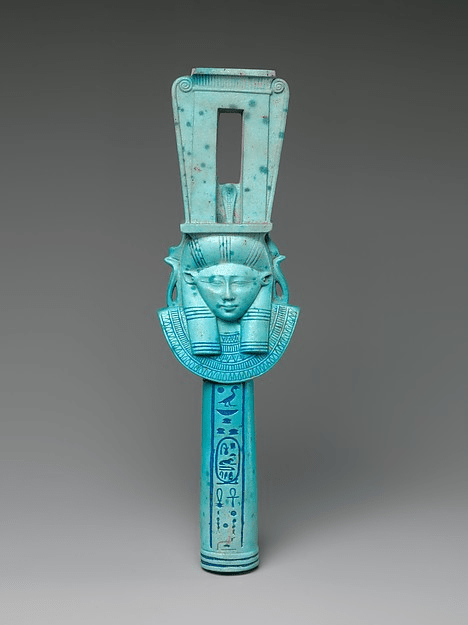
present in the collections of the Metropolitan Museum of Art in New York.
Earthenware being a brittle material, one is entitled to wonder how these fragile instruments could be shaken and agitated to produce their sounds in a sustained rhythm. The Metropolitan Museum of Art in New York, on its website- which has several and somewhat similar examples of this type of sistrum -, puts forward the following hypothesis: “they could have been designed as gifts to a deity rather than as instruments that would have been used often by man. Because they would prove too fragile for frequent use”.
The sistrum is undoubtedly the musical instrument most closely linked to pharaonic Egypt. It is, in particular with the menat, one of the attributes of Hathor, essential divinity of the Egyptian pantheon. “Goddess of love and joy, she is the patroness of music. She embodies eros which allows the perpetual renewal of all forms of life, plant, animal, human and divine. She is the celestial mother” (Isabelle Franco).
If her aspects are multiple, she is most often represented as here, a woman with the ears of a cow wearing a voluminous wig (sometimes surmounted by a naos, horns and a solar disc) or in the form of a cow.

Sistrum with the head of Hathor represented on the walls of the Temple of Abydos.
Thus, the rattling sound that the sistrum emits when it is agitated is supposed to reproduce that which it engenders, in its form of a cow, when it walks in the thickets of papyrus. Another interpretation “links its use to the rite of ‘tearing up the papyri’, originally reserved for the Hathoric cult”.
The ringing of the sistrum is adorned with magical virtues: it can appease the gods, attract their protection and ward off evil spirits. And, if ritualistic priests wave it during ceremonies, it is more generally a “feminine” instrument.
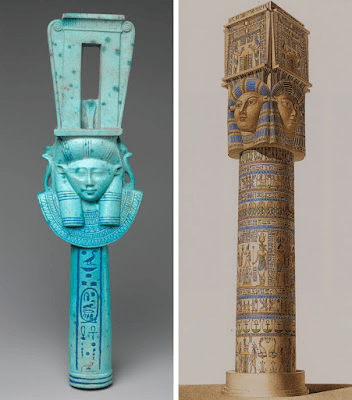
(Description of Egypt, vol. 4, pl. 12)
“Petrified Sound and Digital Color: A Hathor Column in the New Ptolemaic Galleries”
In the study “Petrified Sound and Digital Color: A Hathor Column in the New Ptolemaic Galleries”, published in August 2016 by the Metropolitan Museum of Art, Dieter Arnold, Ann Heywood and Sara Chen develop this fascinating interpretation: “The instrument of music so characteristically represented the goddess that it inspired temple builders of the 18th dynasty to use columns in the form of this emblem in temples of female deities. The basic structure of the sistrum capital also appears in many variations and combinations with other forms of capitals on columns and square pillars. Such rows of sistrum columns could also be understood as a kind of “petrified sound barrier”, softly playing music around the sanctuary of Hathor and magically evoking the appearance of the goddess.”
It was thanks to the generosity of Count Michel Tyskiewicz that this fragment of sistrum joined the collections of the Louvre in 1862, where it was referenced E 3668. This archaeologist and great Polish collector of the second half of the 19th century, who even counted among his customers Napoleon III, settled in France and Italy after leaving his native land and devoted himself entirely to his passion.
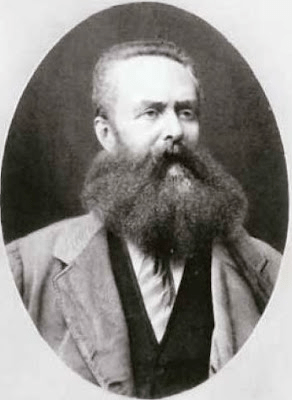
Count Michael Tyszkiewicz,
donator of one hundred and ninety-six Egyptian antiquities to the Louvre Museum
In “Notes and Memories of an Old Collector – My Egyptian Collection”, the Count recalls: “I spent the winter from 1860 to 1861 in Egypt, making excavations at Sakkara, Karnak and Thebes; I had occasion, at the same time, to acquire two collections in Cairo, the most important of which was that of Dr Meymar. Wishing to make a gift to the Boulaq Museum, I chose, for this purpose, a beautiful basalt statue representing a young man standing, dressed in schenti. This statue was sent by the Egyptian government, with other important works, to the Paris Exhibition in 1867, where I had the pleasure of seeing it again. In 1869, I revisited the Boulaq Museum two years later: the statue had disappeared. Returning to Paris in the spring of 1861, I brought there many cases of antiquities. After unpacking everything, I invited MM. de Rougé and de Longpérier to come and see my collection. These two scholars pointed out that it contained several significant objects, the like of which were missing from the Louvre series; the conclusion of their speeches and the compliments they mixed with them was a purchase proposal in the name of the Museum. I refused to sell but was pleased to offer everything as a gift. The next day, the employees of the Louvre came to pack and move my objects.
His generosity thus made him known throughout the world: “thanks to his donation of one hundred and ninety-six Egyptian antiquities to the Louvre Museum, … his name is engraved among the greatest donors of the museum in the Rotunda of Apollo”.
sources:
Sistrum at naos
http://cartelfr.louvre.fr/cartelfr/visite?srv=car_not_frame&idNotice=3529&langue=fr
The technique of making Egyptian earthenware
http://jfbradu.free.fr/egypte/LES%20ANIMAUX/hippopotame/savoir-plus-faience-egypt.php3
Petrified Sound and Digital Color: A Hathor Column in the New Ptolemaic Galleries, August 12, 2016, Dieter Arnold, Curator, Department of Egyptian Art; Ann Heywood, Curator, Department of Objects Conservation; and Sara Chen, Draftsperson, Department of Egyptian Art
https://www.metmuseum.org/blogs/now-at-the-met/2016/hathor-column
Faience Sistrum Inscribed with the Name of Ptolemy I
https://www.metmuseum.org/art/collection/search/546038
Isabelle Franco, Dictionary of Egyptian Mythology, Isabelle Franco, Tallandier, 2013
Donors to the Louvre, Paris, Louvre Museum, 1989
The Tyszkiewicz Collection, W. Fröhner
https://www.persee.fr/doc/mefr_0223-4874_1893_num_13_1_6112
Michel Tyszkiewicz, Notes and Memories of an Old Collector, Archaeological Review, Paris, 1895-1897
A wonderful post that reveals aspects of ancient history little known to me. Thank you for the research you carry out to offer us such great articles ❤️
LikeLiked by 1 person
I am highly obliged for your words, dear Luisa. I try my best, though it is not so easy! Grazie mia cara Amica. 🤗🤗🙏💖😘😘
LikeLiked by 1 person
The pleasure is all mine, Aladin 🙏🙏🙏
LikeLiked by 1 person
Wow, this is another fantastic post! Filled with in-depth and fascinating descriptions of Egyptian artefacts and mythology and lovely images too! Thank you for sharing this Aladin! Love and light, Deborah.
LikeLiked by 1 person
That’s all fascinating because of the amazing Goddesses. 😉😊😇Thank you, dearest Deborah 🙏❤️ Hugs 🫂💖
LikeLiked by 1 person
This is so interesting. I used to love reading about all things Egyptian as a child, you have brought me back to those wonderful days. I have so enjoyed this post, thank you🙏🙂
LikeLiked by 1 person
That is a beautiful reward for my effort, dear Dawn. Thank you.🙏💖🌹
LikeLiked by 1 person
Thanks for this in-depth post about Hathor.
LikeLiked by 1 person
You are welcome. 🤗 Thank you for dropping by. Cheers🙏👍
LikeLiked by 1 person